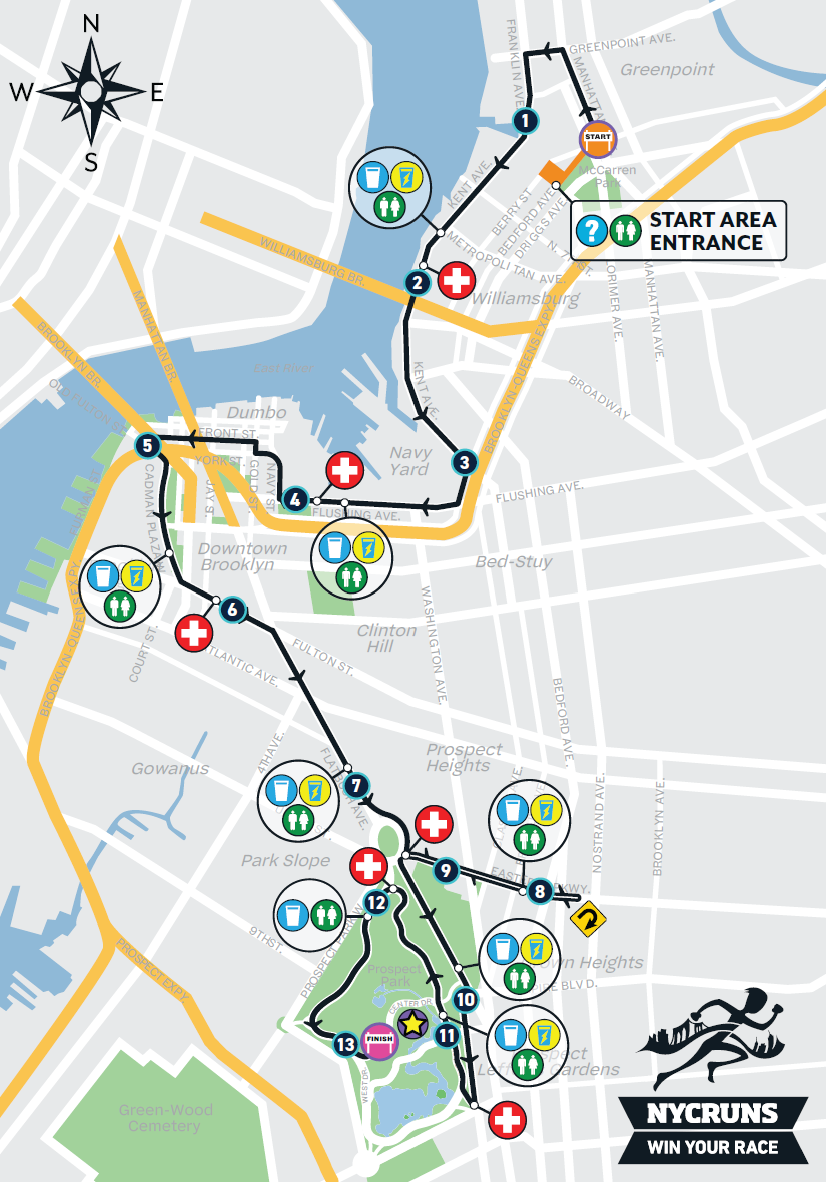This is Part 3 of our series on How to Write Your Own Training Plan. You’ll find Part 2 here. Over the next 8 posts we’ll cover the following topics:
1. Intro
2. Definitions and Terminology
3. Where You Are and Where You Want to Go (⭐You are here.)
4. The Elements of a Training Cycle
5. Workout Purpose & Design - Endurance
6. Workout Purpose & Design - Threshold
7. Workout Purpose & Design - Speed & Hills
8. Putting it All Together - Micro, Meso, & Macrocycles
9. The Extras - Strength, Cross-Training, & Course-Specific Add-Ons
10. Taper & Race Prep
Introduction
Whether it’s a goal of a PR, a BQ, or breaking the next round number, most runners (even if they don’t admit it) start every training cycle with a time goal in mind. That number will guide training decisions, set workout paces, and define success or failure for an event months in the future. Too often, runners simply work backwards from the goal, undertaking the training (and workout paces) that “should” yield the desired results, rather than start from their current fitness.
I can open any number of training books currently on my bookshelf, look up a 3:10 marathon goal, and get 16 weeks of workouts that will allegedly prepare one’s physiology to run 7:15 pace for 26.2 miles. But is the required preparation for a 3:10 on a warm and hilly course the same as September in Berlin? If a runner has just spent the summer doing speedwork for a 5K PR, are their training priorities the same as someone coming off a 50 mile ultra training cycle? Is a runner who always struggles after mile 18 in need of the same training stimuli as someone who has been running 3:12 with even splits for their last three marathons, but can’t break through their pace barrier?
Hopefully these examples make clear that context, training history, goal specifics, and individual physiology all affect which training adaptations will take precedence in a successful plan. Rather than starting with abstract goals, we will start with what we can define, measure, and quantify, and then identify the gaps and areas where we can improve performance. We’ll work toward a course-specific plan that prioritizes the most important aspects of a successful performance, and addresses any gaps or areas of improvement we identify in your own physiology, fitness, or training history.
This exercise requires thoughtful analysis, a bit of legwork when it comes to course research, and objectivity in appraising oneself. I’ve provided a google form that should help organize your thoughts. You’re also welcome to write your answers somewhere with pen and paper, but whatever the format, the actual writing process is a necessary part of the exercise. We’ll be using your responses to these questions throughout the rest of the training design, so don’t just answer in your head.
Understanding the Demands of the Race
There are a lot of factors to consider and decisions to be made when creating a training plan, and I like to start with the known quantities and work from there. Having a good understanding of the race parameters is a prerequisite for developing a workable approach to training. If you’re not familiar with the course and the race protocols, now is a good time to download course maps and read a few race reviews. Also make note of temperature ranges, procedural considerations (early or late starting times, gear requirements for trail races, etc.) that you might want to address in your training plan.
1. What is the race distance?
2. What is the elevation profile?
Be specific. Describing your half marathon as "hilly" is far less helpful than "rolling throughout, with a steep downhill at mile 9 and 400 feet of steady uphill from 10-12." The former tells me I probably want to include hill repeats in my training plan. The latter tells me the types of workouts I’ll need to include, and how I might structure them.
3. What is the surface? (Percentage of the course spent on roads, crushed gravel, technical trail, etc)
4. Are there any additional environmental elements to consider? (Altitude, weather that differs from your training conditions, time zone change to the race location, etc.)
Understanding Where You Are
Even for coaches, one of the hardest parts of designing a plan can be accurately assessing where an athlete’s fitness currently stands in relation to the goal event. Recent race results and workout stats can provide good data, but interpolating how fitness at one distance translates to another requires more nuance than plugging numbers into a pace calculator. To predict how an athlete will respond to particular training stimuli, how much volume they need, and where they fall on the power-endurance spectrum takes a bit of art in addition to science.
The questions below are intended to help you better understand your current fitness, not just as a singular pace or race result, but with the broader view of your development as an athlete. We’ll then place that information in relation to the demands of your goal race to inform training specifics, from plan organization down to training paces and workout design.
1. If you have a recent race result that you feel accurately reflects your fitness, enter it here.
Do not use your PR from 5 years ago. Also resist the urge to “adjust” a performance that didn’t go as you hoped. (i.e. I would have run XX:XX if it hadn’t been hot, cold, humid, raining, etc.) If you don’t have a recent race result, we’ll talk about other options to check fitness below.*
2. How does this race distance relate to your goal race?
As a general rule, the further apart the race distances are, the harder it will be to relate fitness at one distance to the other. It’s tough to assess your endurance training needs for a marathon on a 5K result, but conversely, a 10K time will give you a very good sense of half marathon readiness. Also note that a similar distance on a very different surface or elevation profile to your goal race will be less directly applicable in determining race fitness.
3. What is your current training volume?
If you haven’t raced recently, this should be the average of your last 6-8 weeks of training. If you’ve just come off a race within the last 2-3 weeks, this can be closer to your average mileage during the training cycle. Please note that I said average, not ‘peak week.’
4. What is your general training history?
This doesn’t need to be a long-form essay, but your longer-term experience as a runner does matter. If you’ve been running 40-50 miles a week for 10 years you’ll have an easier time increasing your weekly volume to 60 than someone who has only done one training cycle at 50 miles a week. If you’ve spent the last 5 years running track 5Ks and you’re now jumping up to a road half, you’ll likely need less speedwork than someone who ran 3 marathons last year.
5. Are there physical aspects of training or racing where you excel or things come easily?
This can be any area where you can leverage your physical strengths. Does speed come quickly? Are you confident in your ability to run hills?
6. What are the areas where you tend to struggle?
This response can be about mindset, or physical challenges. Often the things we see as inherent limitations can be addressed in training with some thought and creativity. Do you always go out too fast in races? Do you struggle with GI issues on the course? Do race-day nerves interfere with performance?
7. Have you had any major injuries that affect your training, or have you historically been troubled by repetitive stress injuries in your training?
Some injuries will require training adaptations to stay healthy. If you have a history of shin splints, runner’s knee, IT band issues, or other classic RSI type injuries, it’s worth looking back at your training logs to see if there are patterns to when these develop.
*Running a time trial as a basis of fitness:
If you don’t have an applicable race result (or even if you do), running a time trial to help set training paces is your best option. For goal races from the 10K to marathon (and beyond), running a time trial to estimate your threshold pace will be most useful for workout design. The Joe Friel method is probably easiest–run a 10-minute warm-up, then pick up the pace to a steady effort you can hold for 30 minutes. Your average heart rate over the last 10 minutes is your threshold heart rate, and your average pace is a good guide for threshold pace (under similar conditions.)

Understanding Your Physiology
We’ve now identified the primary aspects of your race that we’ll need to address in the course of training, as well as some data points on your current fitness. Before we can chart a course from where you are today to race day fitness, we need to understand a bit more about you as an athlete and how you respond to training.
Let’s Talk About Muscle Fiber Types
Most athletes are familiar with the concept of slow twitch (ST) and fast twitch (FT) muscle, and are probably aware that a major distinction between the two is in how they create energy for movement. ST fiber has a rich blood supply to deliver oxygen and as a result, has the capacity to produce energy oxidatively from fat or carbohydrate sources. This process is highly efficient from a fuel-to-energy-output standpoint, but is a slow process with high oxygen demands.
FT fiber is usually larger in size and greater in strength than ST, and is distinguished by a much lower capacity to produce its energy oxidatively. Instead, ST fiber relies heavily on fermentation of stored carbohydrate (glycogen), a process which releases 1/16th the energy of the oxidative process, but does it in 1/100th the time and without an immediate demand for oxygen.
The reason why I’m reminding you of high school biology is that there is wide variation across the population in how much of each fiber type a person is born with, and that genetic predisposition affects which workouts and race distances might come more easily to you. Fiber types are also affected by training, and having an idea of where you fall on the ST-FT spectrum can help guide decisions as you’re designing a plan.
In a classic study from 19761 that included both male and female athletes, well-trained sprinters exhibited slow-twitch characteristics in only about 27% of their muscle fiber. Among middle-distance runners, ST fiber rose to about 61%, and in distance runners, ST represented about 69% of total muscle. Clearly, having a greater proportion of FT fiber is an advantage in speed and power sports, while ST dominant athletes are naturally suited for endurance sports.
You may already have a sense of where you fall on the fiber type spectrum. The sports you gravitated to in childhood and adolescence often provide a clue, as do the types of run workouts you most enjoy now. If you love speedwork but dread long runs, you probably skew more fast twitch. Faster twitch athletes also tend to get more sore than their ST counterparts after hard workouts, and put on muscle mass more easily. If you’ve raced at a variety of distances, you can also look at predictive pace charts like Jack Daniels and you’ll probably find that for FT-oriented athletes, your half or full marathon pace predicts a slower mile or 3K time than you can run.
If the FT profile sounds like you, don’t despair. Numerous studies, including one following trained athletes over 20 years of training2 have confirmed that consistent endurance exercise can remodel significant proportions of FT fiber into ST over time. Study participants who were less trained or started out with a higher proportion of FT fiber were able to convert the greatest amount to ST, while the participants who were already highly trained or were ST-dominant saw less change. If you are a more naturally fast-twitch person, you absolutely have the capacity to optimize your physiology for distance, but you’ll need to put a bit more emphasis on endurance adaptations in your training plan. Once we get into the specifics of plan and workout design we’ll talk about the adjustments in detail, but for now, just note that your dominant fiber type (whether it’s FT or ST) does play an important role in training response.
Moving Forward
Congratulations. You now have assembled far more data to inform your training cycle decisions than most runners (and even many coaches) will. In the next post, we’ll talk about how to evaluate which aspects of training are most important for your race, and which types of workouts will be most effective. We’ll also discuss different philosophies and models for organizing a training cycle, and how to decide which might be the best fit for you.
- Costill DL, Daniels J, Evans W, Fink W, Krahenbuhl G, Saltin B. Skeletal muscle enzymes and fiber composition in male and female track athletes. J Appl Physiol. 1976 Feb;40(2):149-54. doi: 10.1152/jappl.1976.40.2.149. PMID: 129449.
-
Trappe SW, Costill DL, Fink WJ, Pearson DR. Skeletal muscle characteristics among distance runners: a 20-yr follow-up study. J Appl Physiol (1985). 1995 Mar;78(3):823-9. doi: 10.1152/jappl.1995.78.3.823. PMID: 7775325.



